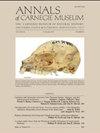新墨西哥州宾夕法尼亚州的一种掠生瓦拉尼类真龙
IF 0.9
4区 地球科学
Q4 PALEONTOLOGY
引用次数: 0
摘要
新墨西哥州上宾夕法尼亚地区发现的一具小型四足动物的不完整骨架,代表了一种名为Eoscansor cobrensis的新属和新种。这具骨架来自新墨西哥州里奥阿里巴县Cañon del Cobre的El Cobre峡谷地层的Cobrean(弗吉尼亚)区间。Eoscansor是一种小型变异类人猿,主要区别于其他变异类人猿的是其手、足、跖骨和指骨的独特结构。解剖结构的不同方面表明,Eoscansor是一种攀援动物,可能是树栖动物,是目前已知的最古老的四足动物。这些特征包括:爪子、指骨和跖骨的适应,表明了抓取、依附和攀爬的能力;前肢和后肢之间的高爪曲率和肢长等效;每SVL的体重在现存爬行蜥蜴的范围内;胫骨长度/股骨长度比非常低;较低的重心有利于倾斜的表面拥抱姿势。本文章由计算机程序翻译,如有差异,请以英文原文为准。
A Scansorial Varanopid Eupelycosaur from the Pennsylvanian of New Mexico
ABSTRACT An incomplete skeleton of a small tetrapod from the Upper Pennsylvanian of New Mexico represents a new genus and species of varanopid eupelycosaur named Eoscansor cobrensis. This skeleton is from the Cobrean (Virgilian) interval of the El Cobre Canyon Formation in the Cañon del Cobre of Rio Arriba County, New Mexico. Eoscansor is a small varanopid distinguished from other varanopids primarily by the unique structure of its manus and pes metapodials and phalanges. Diverse aspects of its anatomy indicate that Eoscansor was a climber, and possibly arboreal, the oldest such tetrapod now known. These features include: claw, phalangeal, and metapodial adaptations indicative of grasping, clinging, and climbing ability; equivalence of high claw curvature and limb length between the fore- and hind limbs; body mass per SVL within the range of extant climbing lizards; very low tibia length/femur length ratio; and a low center of gravity to facilitate an inclined surface-hugging posture.
求助全文
通过发布文献求助,成功后即可免费获取论文全文。
去求助
来源期刊

Annals of Carnegie Museum
综合性期刊-动物学
CiteScore
2.50
自引率
18.20%
发文量
4
审稿时长
>12 weeks
期刊介绍:
Annals of Carnegie Museum is a quarterly journal that publishes peer-reviewed short and medium-length original scientific contributions in organismal biology, earth sciences, and anthropology, in 40 by 52.5 pica format (168 by 220 mm or 6-5/8 by 8-5/8 inches). Subject matter must be relevant to Carnegie Museum of Natural History scientific sections or Powdermill Nature Reserve (PNR), preferably with connection to the Carnegie collection and/or personnel. Carnegie Museum staff and research associates receive publication priority, but others are encouraged to submit papers, especially those manuscripts explicitly based on the Carnegie collection.
 求助内容:
求助内容: 应助结果提醒方式:
应助结果提醒方式:


